Business Finance: Costing, Variance Analysis & Investment Appraisal
VerifiedAdded on 2023/06/11
|23
|5384
|394
Case Study
AI Summary
This document presents a comprehensive solution to a business finance case study, divided into two main parts. The first part focuses on cost calculation, including contribution per unit, breakeven point analysis, margin of safety, and profit calculation using marginal and absorption costing methods. It also covers the importance of standard costing and variance analysis, providing calculations and comments on material and labor variances, along with a budget preparation for controlling operations. The second part delves into investment appraisal techniques, such as payback period, net present value, and internal rate of return, offering advice on project suitability. Additionally, it includes a risk assessment of Omega Limited using accounting ratios, identifies non-finance performance indicators, and discusses the impact of pricing policy on business performance. This solved assignment is available on Desklib, a platform offering study tools and resources for students.
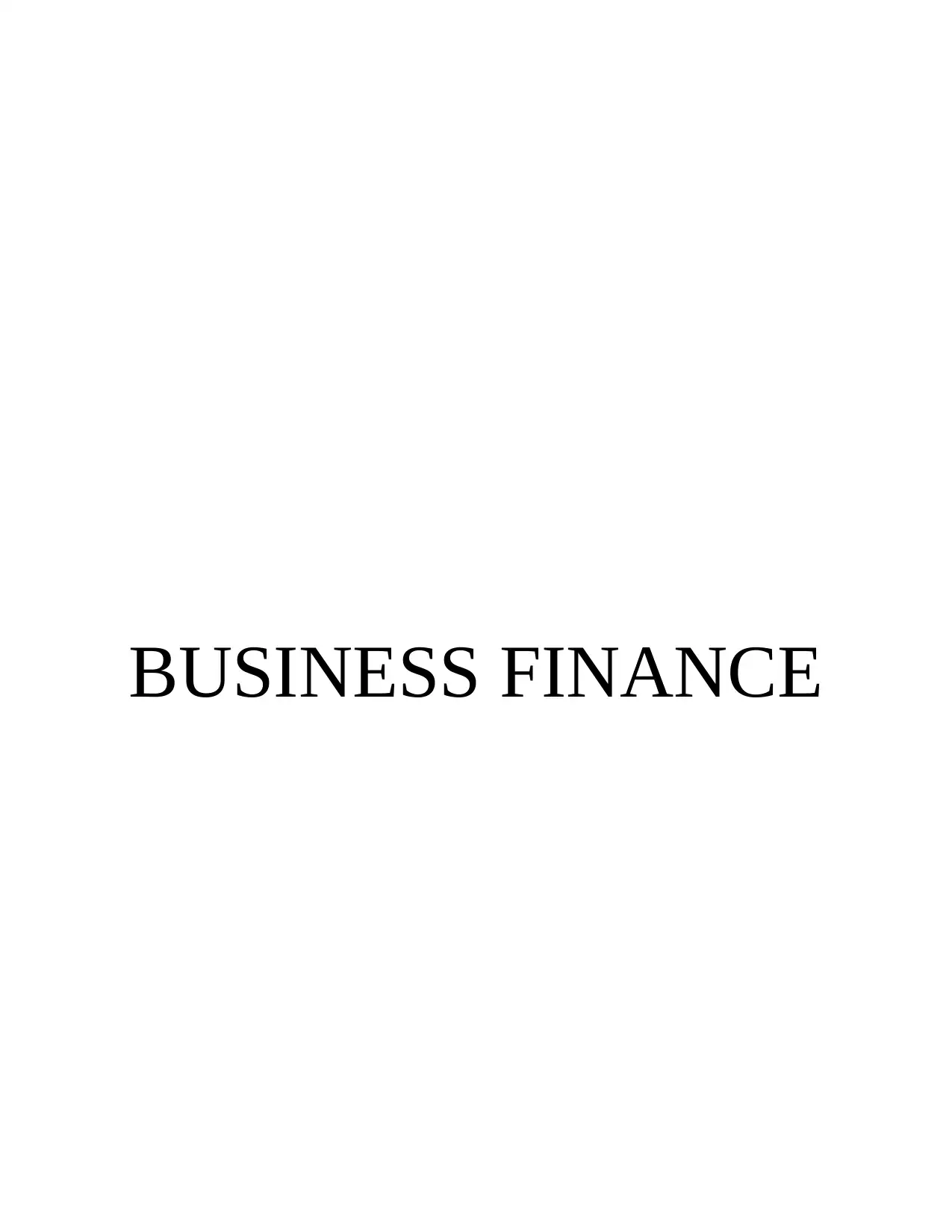
BUSINESS FINANCE
Paraphrase This Document
Need a fresh take? Get an instant paraphrase of this document with our AI Paraphraser
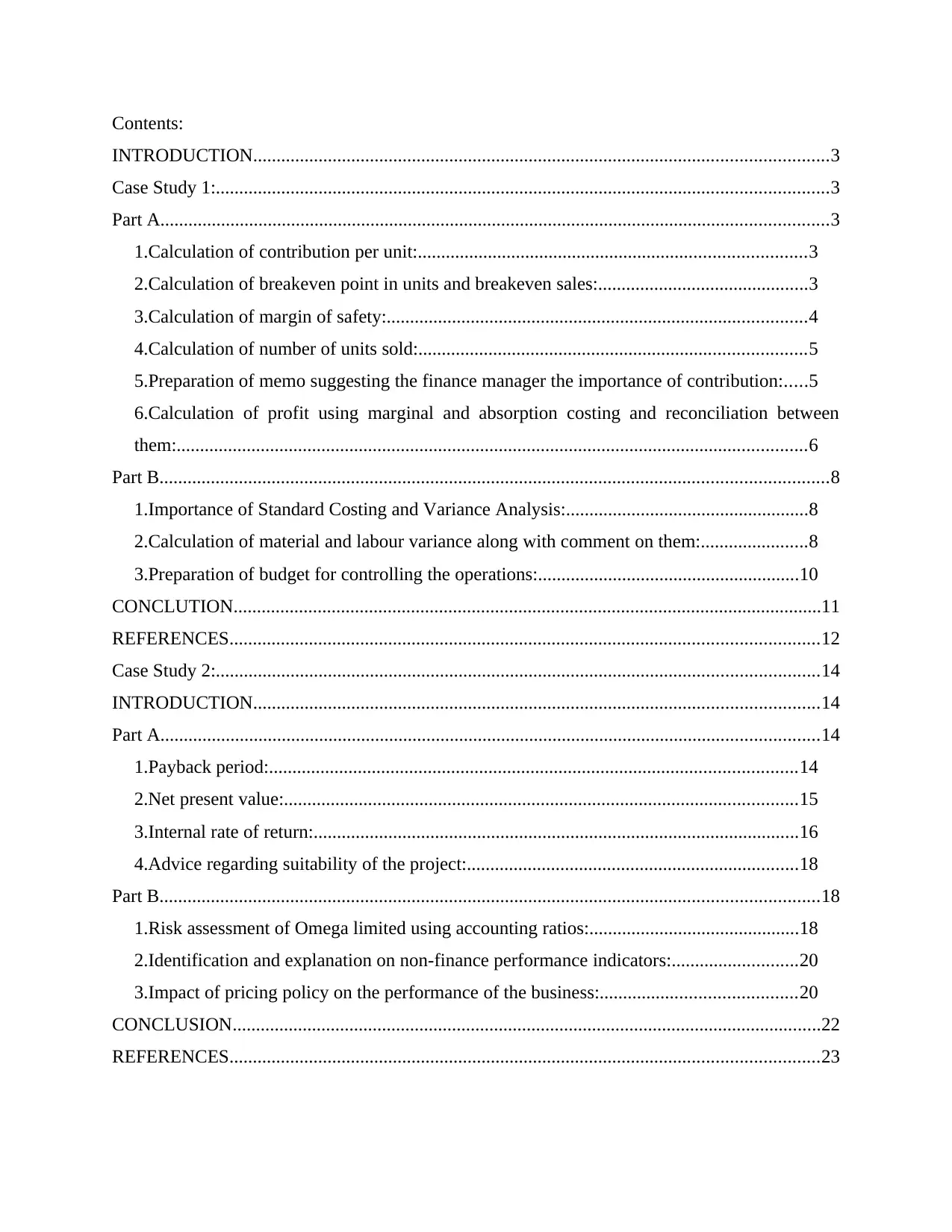
Contents:
INTRODUCTION...........................................................................................................................3
Case Study 1:...................................................................................................................................3
Part A...............................................................................................................................................3
1.Calculation of contribution per unit:...................................................................................3
2.Calculation of breakeven point in units and breakeven sales:.............................................3
3.Calculation of margin of safety:..........................................................................................4
4.Calculation of number of units sold:...................................................................................5
5.Preparation of memo suggesting the finance manager the importance of contribution:.....5
6.Calculation of profit using marginal and absorption costing and reconciliation between
them:.......................................................................................................................................6
Part B...............................................................................................................................................8
1.Importance of Standard Costing and Variance Analysis:....................................................8
2.Calculation of material and labour variance along with comment on them:.......................8
3.Preparation of budget for controlling the operations:........................................................10
CONCLUTION..............................................................................................................................11
REFERENCES..............................................................................................................................12
Case Study 2:.................................................................................................................................14
INTRODUCTION.........................................................................................................................14
Part A.............................................................................................................................................14
1.Payback period:.................................................................................................................14
2.Net present value:..............................................................................................................15
3.Internal rate of return:........................................................................................................16
4.Advice regarding suitability of the project:.......................................................................18
Part B.............................................................................................................................................18
1.Risk assessment of Omega limited using accounting ratios:.............................................18
2.Identification and explanation on non-finance performance indicators:...........................20
3.Impact of pricing policy on the performance of the business:..........................................20
CONCLUSION..............................................................................................................................22
REFERENCES..............................................................................................................................23
INTRODUCTION...........................................................................................................................3
Case Study 1:...................................................................................................................................3
Part A...............................................................................................................................................3
1.Calculation of contribution per unit:...................................................................................3
2.Calculation of breakeven point in units and breakeven sales:.............................................3
3.Calculation of margin of safety:..........................................................................................4
4.Calculation of number of units sold:...................................................................................5
5.Preparation of memo suggesting the finance manager the importance of contribution:.....5
6.Calculation of profit using marginal and absorption costing and reconciliation between
them:.......................................................................................................................................6
Part B...............................................................................................................................................8
1.Importance of Standard Costing and Variance Analysis:....................................................8
2.Calculation of material and labour variance along with comment on them:.......................8
3.Preparation of budget for controlling the operations:........................................................10
CONCLUTION..............................................................................................................................11
REFERENCES..............................................................................................................................12
Case Study 2:.................................................................................................................................14
INTRODUCTION.........................................................................................................................14
Part A.............................................................................................................................................14
1.Payback period:.................................................................................................................14
2.Net present value:..............................................................................................................15
3.Internal rate of return:........................................................................................................16
4.Advice regarding suitability of the project:.......................................................................18
Part B.............................................................................................................................................18
1.Risk assessment of Omega limited using accounting ratios:.............................................18
2.Identification and explanation on non-finance performance indicators:...........................20
3.Impact of pricing policy on the performance of the business:..........................................20
CONCLUSION..............................................................................................................................22
REFERENCES..............................................................................................................................23
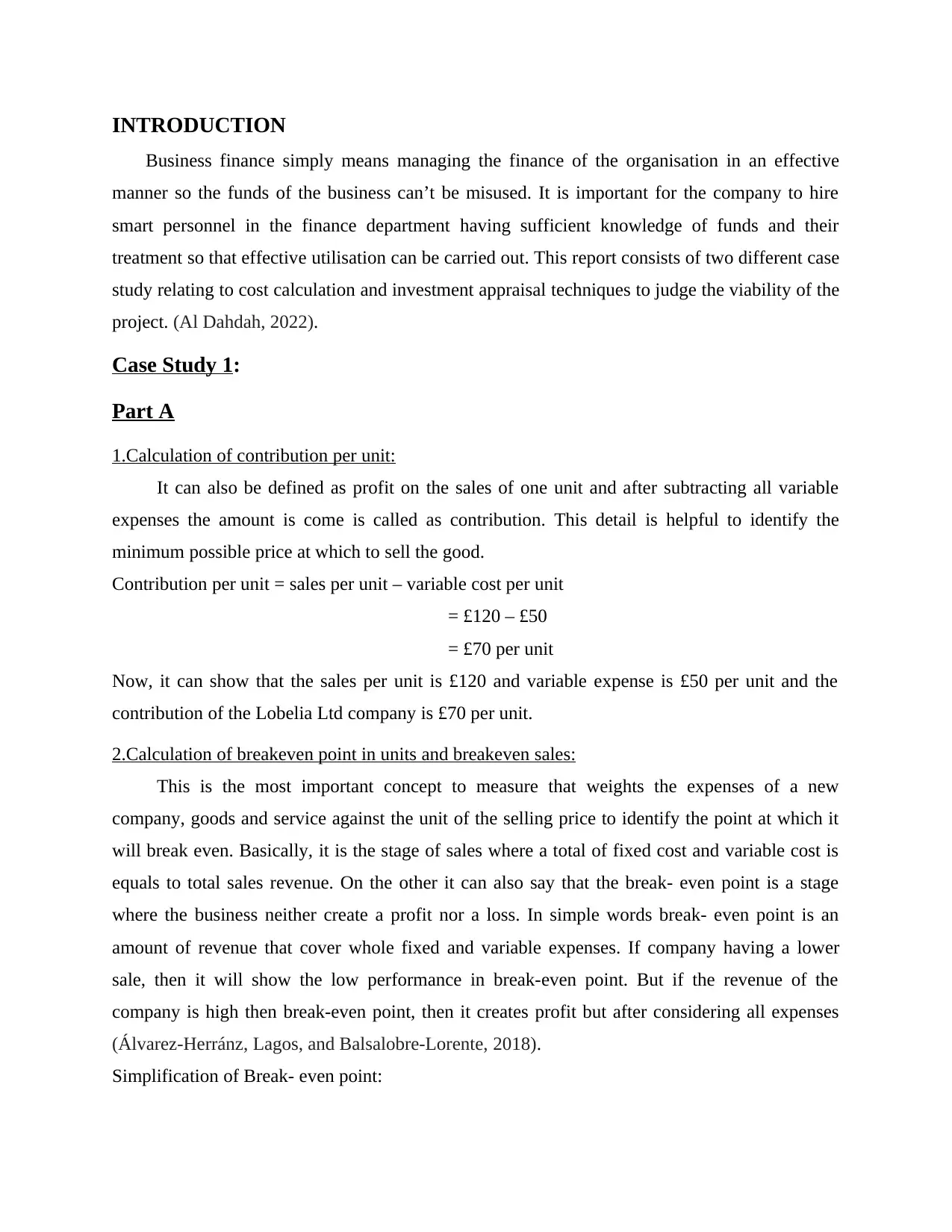
INTRODUCTION
Business finance simply means managing the finance of the organisation in an effective
manner so the funds of the business can’t be misused. It is important for the company to hire
smart personnel in the finance department having sufficient knowledge of funds and their
treatment so that effective utilisation can be carried out. This report consists of two different case
study relating to cost calculation and investment appraisal techniques to judge the viability of the
project. (Al Dahdah, 2022).
Case Study 1:
Part A
1.Calculation of contribution per unit:
It can also be defined as profit on the sales of one unit and after subtracting all variable
expenses the amount is come is called as contribution. This detail is helpful to identify the
minimum possible price at which to sell the good.
Contribution per unit = sales per unit – variable cost per unit
= £120 – £50
= £70 per unit
Now, it can show that the sales per unit is £120 and variable expense is £50 per unit and the
contribution of the Lobelia Ltd company is £70 per unit.
2.Calculation of breakeven point in units and breakeven sales:
This is the most important concept to measure that weights the expenses of a new
company, goods and service against the unit of the selling price to identify the point at which it
will break even. Basically, it is the stage of sales where a total of fixed cost and variable cost is
equals to total sales revenue. On the other it can also say that the break- even point is a stage
where the business neither create a profit nor a loss. In simple words break- even point is an
amount of revenue that cover whole fixed and variable expenses. If company having a lower
sale, then it will show the low performance in break-even point. But if the revenue of the
company is high then break-even point, then it creates profit but after considering all expenses
(Álvarez‐Herránz, Lagos, and Balsalobre‐Lorente, 2018).
Simplification of Break- even point:
Business finance simply means managing the finance of the organisation in an effective
manner so the funds of the business can’t be misused. It is important for the company to hire
smart personnel in the finance department having sufficient knowledge of funds and their
treatment so that effective utilisation can be carried out. This report consists of two different case
study relating to cost calculation and investment appraisal techniques to judge the viability of the
project. (Al Dahdah, 2022).
Case Study 1:
Part A
1.Calculation of contribution per unit:
It can also be defined as profit on the sales of one unit and after subtracting all variable
expenses the amount is come is called as contribution. This detail is helpful to identify the
minimum possible price at which to sell the good.
Contribution per unit = sales per unit – variable cost per unit
= £120 – £50
= £70 per unit
Now, it can show that the sales per unit is £120 and variable expense is £50 per unit and the
contribution of the Lobelia Ltd company is £70 per unit.
2.Calculation of breakeven point in units and breakeven sales:
This is the most important concept to measure that weights the expenses of a new
company, goods and service against the unit of the selling price to identify the point at which it
will break even. Basically, it is the stage of sales where a total of fixed cost and variable cost is
equals to total sales revenue. On the other it can also say that the break- even point is a stage
where the business neither create a profit nor a loss. In simple words break- even point is an
amount of revenue that cover whole fixed and variable expenses. If company having a lower
sale, then it will show the low performance in break-even point. But if the revenue of the
company is high then break-even point, then it creates profit but after considering all expenses
(Álvarez‐Herránz, Lagos, and Balsalobre‐Lorente, 2018).
Simplification of Break- even point:
⊘ This is a preview!⊘
Do you want full access?
Subscribe today to unlock all pages.

Trusted by 1+ million students worldwide
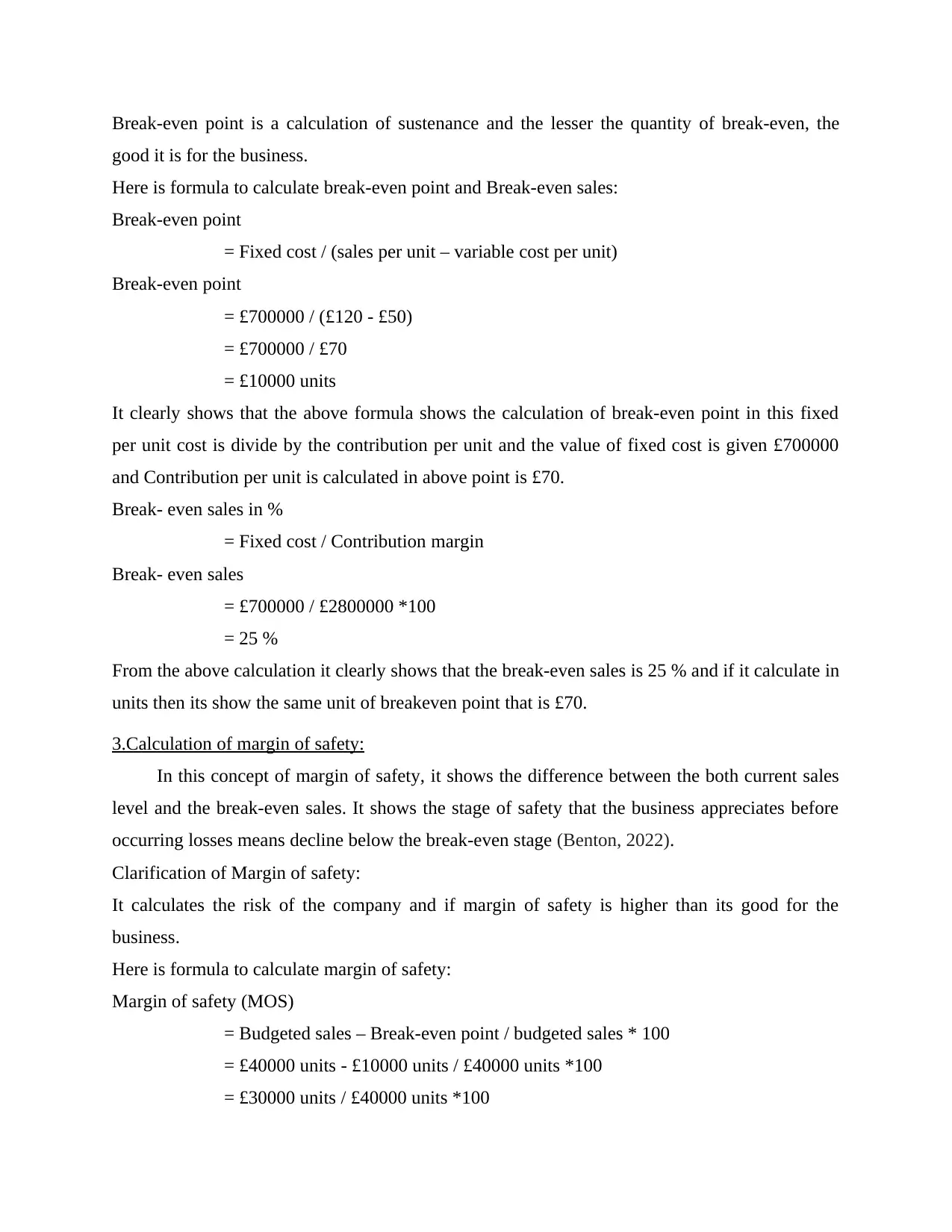
Break-even point is a calculation of sustenance and the lesser the quantity of break-even, the
good it is for the business.
Here is formula to calculate break-even point and Break-even sales:
Break-even point
= Fixed cost / (sales per unit – variable cost per unit)
Break-even point
= £700000 / (£120 - £50)
= £700000 / £70
= £10000 units
It clearly shows that the above formula shows the calculation of break-even point in this fixed
per unit cost is divide by the contribution per unit and the value of fixed cost is given £700000
and Contribution per unit is calculated in above point is £70.
Break- even sales in %
= Fixed cost / Contribution margin
Break- even sales
= £700000 / £2800000 *100
= 25 %
From the above calculation it clearly shows that the break-even sales is 25 % and if it calculate in
units then its show the same unit of breakeven point that is £70.
3.Calculation of margin of safety:
In this concept of margin of safety, it shows the difference between the both current sales
level and the break-even sales. It shows the stage of safety that the business appreciates before
occurring losses means decline below the break-even stage (Benton, 2022).
Clarification of Margin of safety:
It calculates the risk of the company and if margin of safety is higher than its good for the
business.
Here is formula to calculate margin of safety:
Margin of safety (MOS)
= Budgeted sales – Break-even point / budgeted sales * 100
= £40000 units - £10000 units / £40000 units *100
= £30000 units / £40000 units *100
good it is for the business.
Here is formula to calculate break-even point and Break-even sales:
Break-even point
= Fixed cost / (sales per unit – variable cost per unit)
Break-even point
= £700000 / (£120 - £50)
= £700000 / £70
= £10000 units
It clearly shows that the above formula shows the calculation of break-even point in this fixed
per unit cost is divide by the contribution per unit and the value of fixed cost is given £700000
and Contribution per unit is calculated in above point is £70.
Break- even sales in %
= Fixed cost / Contribution margin
Break- even sales
= £700000 / £2800000 *100
= 25 %
From the above calculation it clearly shows that the break-even sales is 25 % and if it calculate in
units then its show the same unit of breakeven point that is £70.
3.Calculation of margin of safety:
In this concept of margin of safety, it shows the difference between the both current sales
level and the break-even sales. It shows the stage of safety that the business appreciates before
occurring losses means decline below the break-even stage (Benton, 2022).
Clarification of Margin of safety:
It calculates the risk of the company and if margin of safety is higher than its good for the
business.
Here is formula to calculate margin of safety:
Margin of safety (MOS)
= Budgeted sales – Break-even point / budgeted sales * 100
= £40000 units - £10000 units / £40000 units *100
= £30000 units / £40000 units *100
Paraphrase This Document
Need a fresh take? Get an instant paraphrase of this document with our AI Paraphraser
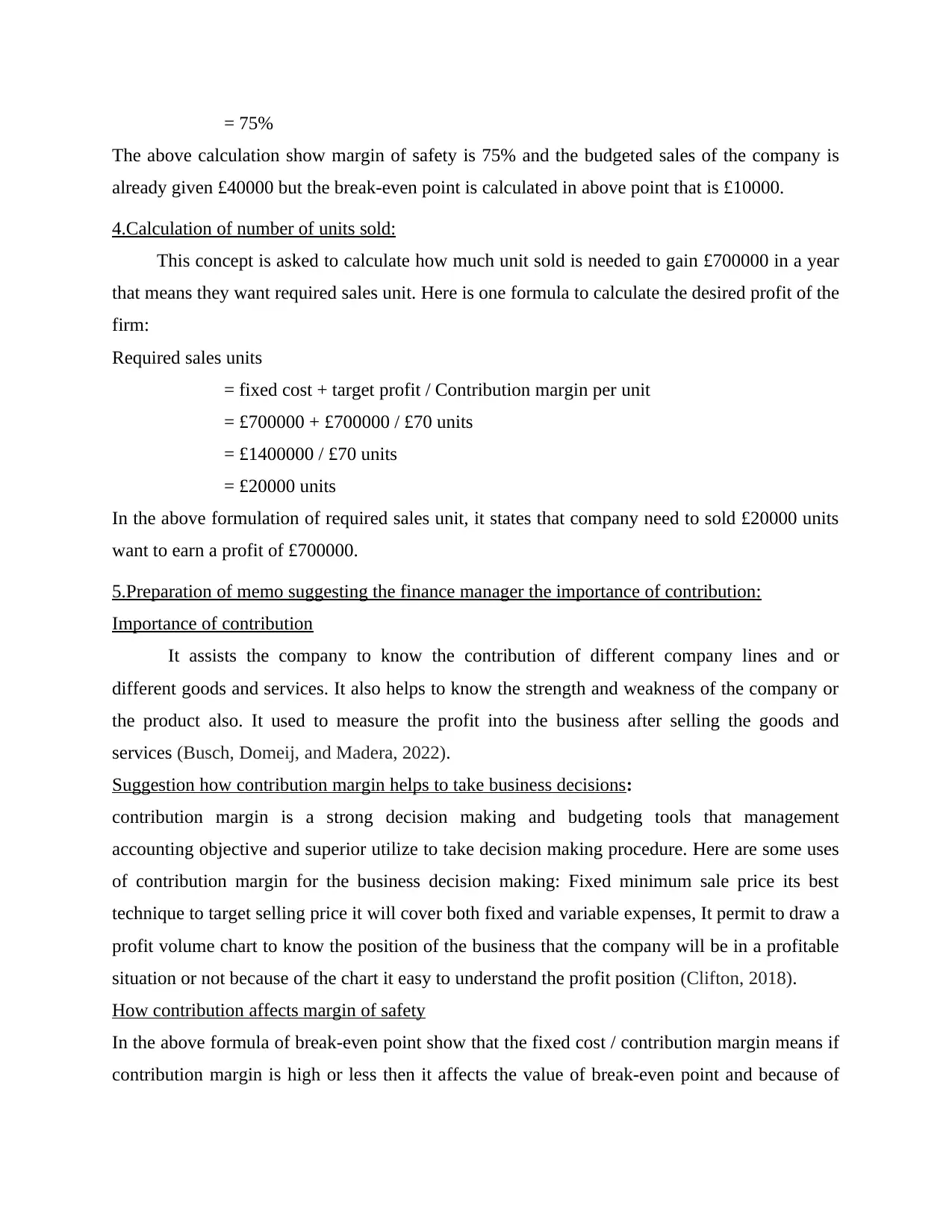
= 75%
The above calculation show margin of safety is 75% and the budgeted sales of the company is
already given £40000 but the break-even point is calculated in above point that is £10000.
4.Calculation of number of units sold:
This concept is asked to calculate how much unit sold is needed to gain £700000 in a year
that means they want required sales unit. Here is one formula to calculate the desired profit of the
firm:
Required sales units
= fixed cost + target profit / Contribution margin per unit
= £700000 + £700000 / £70 units
= £1400000 / £70 units
= £20000 units
In the above formulation of required sales unit, it states that company need to sold £20000 units
want to earn a profit of £700000.
5.Preparation of memo suggesting the finance manager the importance of contribution:
Importance of contribution
It assists the company to know the contribution of different company lines and or
different goods and services. It also helps to know the strength and weakness of the company or
the product also. It used to measure the profit into the business after selling the goods and
services (Busch, Domeij, and Madera, 2022).
Suggestion how contribution margin helps to take business decisions:
contribution margin is a strong decision making and budgeting tools that management
accounting objective and superior utilize to take decision making procedure. Here are some uses
of contribution margin for the business decision making: Fixed minimum sale price its best
technique to target selling price it will cover both fixed and variable expenses, It permit to draw a
profit volume chart to know the position of the business that the company will be in a profitable
situation or not because of the chart it easy to understand the profit position (Clifton, 2018).
How contribution affects margin of safety
In the above formula of break-even point show that the fixed cost / contribution margin means if
contribution margin is high or less then it affects the value of break-even point and because of
The above calculation show margin of safety is 75% and the budgeted sales of the company is
already given £40000 but the break-even point is calculated in above point that is £10000.
4.Calculation of number of units sold:
This concept is asked to calculate how much unit sold is needed to gain £700000 in a year
that means they want required sales unit. Here is one formula to calculate the desired profit of the
firm:
Required sales units
= fixed cost + target profit / Contribution margin per unit
= £700000 + £700000 / £70 units
= £1400000 / £70 units
= £20000 units
In the above formulation of required sales unit, it states that company need to sold £20000 units
want to earn a profit of £700000.
5.Preparation of memo suggesting the finance manager the importance of contribution:
Importance of contribution
It assists the company to know the contribution of different company lines and or
different goods and services. It also helps to know the strength and weakness of the company or
the product also. It used to measure the profit into the business after selling the goods and
services (Busch, Domeij, and Madera, 2022).
Suggestion how contribution margin helps to take business decisions:
contribution margin is a strong decision making and budgeting tools that management
accounting objective and superior utilize to take decision making procedure. Here are some uses
of contribution margin for the business decision making: Fixed minimum sale price its best
technique to target selling price it will cover both fixed and variable expenses, It permit to draw a
profit volume chart to know the position of the business that the company will be in a profitable
situation or not because of the chart it easy to understand the profit position (Clifton, 2018).
How contribution affects margin of safety
In the above formula of break-even point show that the fixed cost / contribution margin means if
contribution margin is high or less then it affects the value of break-even point and because of
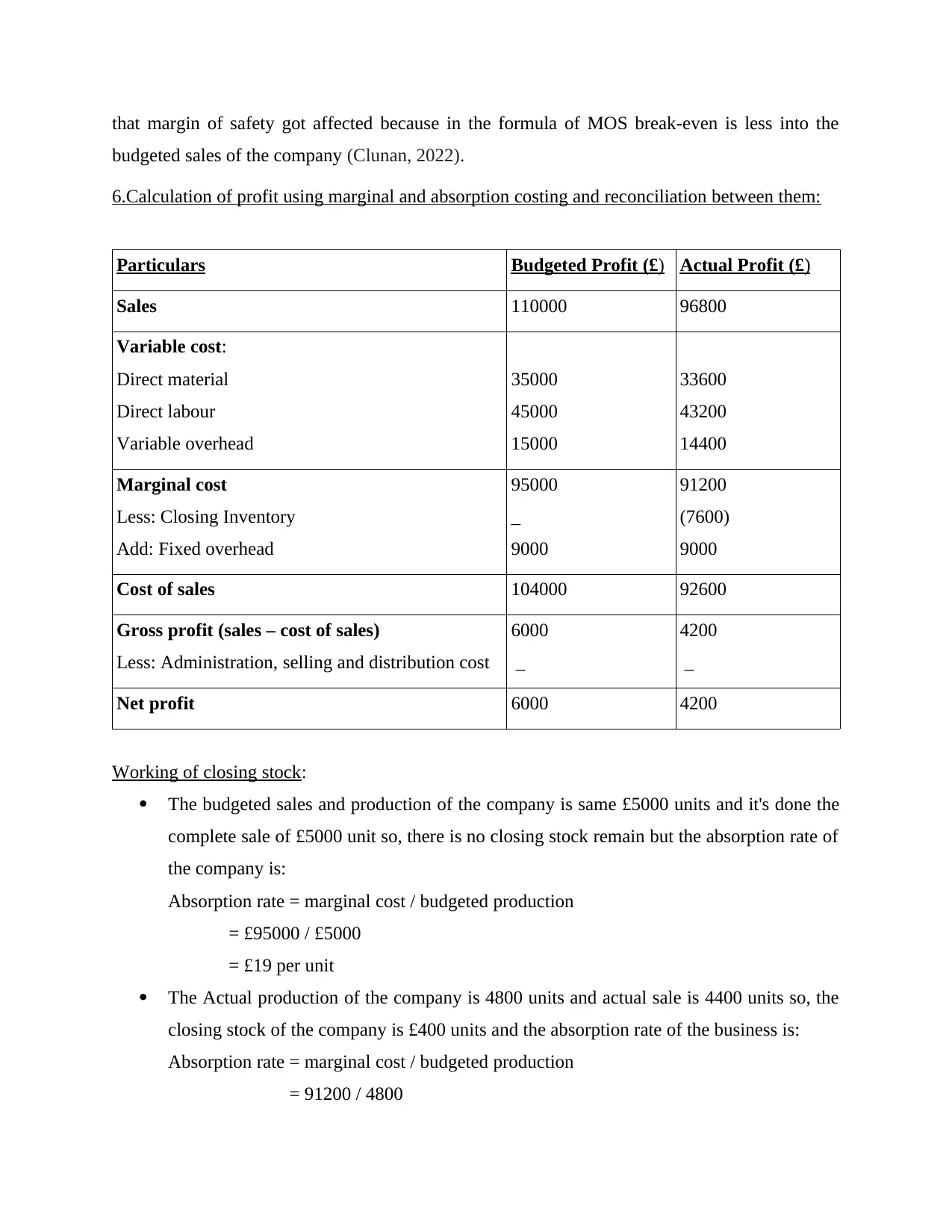
that margin of safety got affected because in the formula of MOS break-even is less into the
budgeted sales of the company (Clunan, 2022).
6.Calculation of profit using marginal and absorption costing and reconciliation between them:
Particulars Budgeted Profit (£) Actual Profit (£)
Sales 110000 96800
Variable cost:
Direct material
Direct labour
Variable overhead
35000
45000
15000
33600
43200
14400
Marginal cost
Less: Closing Inventory
Add: Fixed overhead
95000
_
9000
91200
(7600)
9000
Cost of sales 104000 92600
Gross profit (sales – cost of sales)
Less: Administration, selling and distribution cost
6000
_
4200
_
Net profit 6000 4200
Working of closing stock:
The budgeted sales and production of the company is same £5000 units and it's done the
complete sale of £5000 unit so, there is no closing stock remain but the absorption rate of
the company is:
Absorption rate = marginal cost / budgeted production
= £95000 / £5000
= £19 per unit
The Actual production of the company is 4800 units and actual sale is 4400 units so, the
closing stock of the company is £400 units and the absorption rate of the business is:
Absorption rate = marginal cost / budgeted production
= 91200 / 4800
budgeted sales of the company (Clunan, 2022).
6.Calculation of profit using marginal and absorption costing and reconciliation between them:
Particulars Budgeted Profit (£) Actual Profit (£)
Sales 110000 96800
Variable cost:
Direct material
Direct labour
Variable overhead
35000
45000
15000
33600
43200
14400
Marginal cost
Less: Closing Inventory
Add: Fixed overhead
95000
_
9000
91200
(7600)
9000
Cost of sales 104000 92600
Gross profit (sales – cost of sales)
Less: Administration, selling and distribution cost
6000
_
4200
_
Net profit 6000 4200
Working of closing stock:
The budgeted sales and production of the company is same £5000 units and it's done the
complete sale of £5000 unit so, there is no closing stock remain but the absorption rate of
the company is:
Absorption rate = marginal cost / budgeted production
= £95000 / £5000
= £19 per unit
The Actual production of the company is 4800 units and actual sale is 4400 units so, the
closing stock of the company is £400 units and the absorption rate of the business is:
Absorption rate = marginal cost / budgeted production
= 91200 / 4800
⊘ This is a preview!⊘
Do you want full access?
Subscribe today to unlock all pages.

Trusted by 1+ million students worldwide
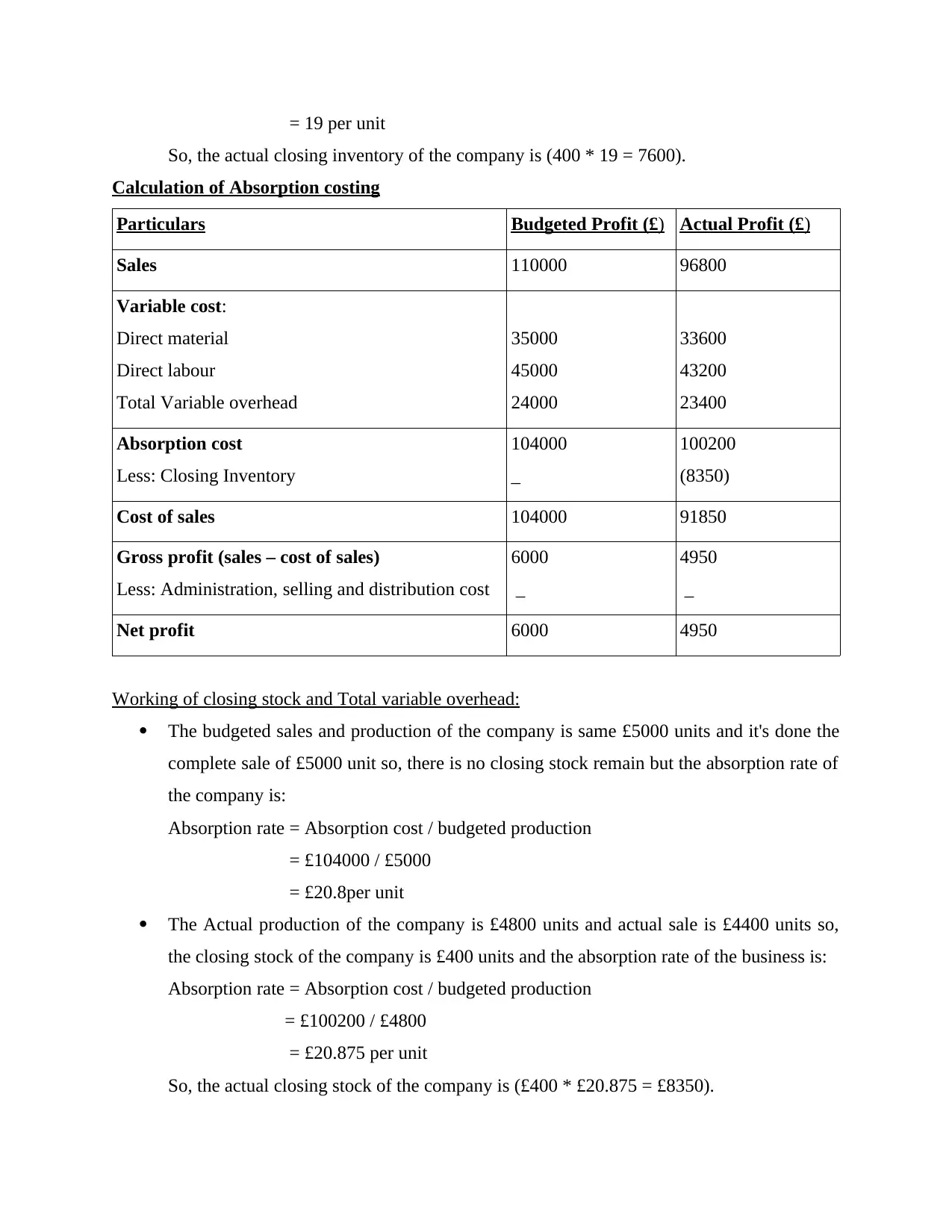
= 19 per unit
So, the actual closing inventory of the company is (400 * 19 = 7600).
Calculation of Absorption costing
Particulars Budgeted Profit (£) Actual Profit (£)
Sales 110000 96800
Variable cost:
Direct material
Direct labour
Total Variable overhead
35000
45000
24000
33600
43200
23400
Absorption cost
Less: Closing Inventory
104000
_
100200
(8350)
Cost of sales 104000 91850
Gross profit (sales – cost of sales)
Less: Administration, selling and distribution cost
6000
_
4950
_
Net profit 6000 4950
Working of closing stock and Total variable overhead:
The budgeted sales and production of the company is same £5000 units and it's done the
complete sale of £5000 unit so, there is no closing stock remain but the absorption rate of
the company is:
Absorption rate = Absorption cost / budgeted production
= £104000 / £5000
= £20.8per unit
The Actual production of the company is £4800 units and actual sale is £4400 units so,
the closing stock of the company is £400 units and the absorption rate of the business is:
Absorption rate = Absorption cost / budgeted production
= £100200 / £4800
= £20.875 per unit
So, the actual closing stock of the company is (£400 * £20.875 = £8350).
So, the actual closing inventory of the company is (400 * 19 = 7600).
Calculation of Absorption costing
Particulars Budgeted Profit (£) Actual Profit (£)
Sales 110000 96800
Variable cost:
Direct material
Direct labour
Total Variable overhead
35000
45000
24000
33600
43200
23400
Absorption cost
Less: Closing Inventory
104000
_
100200
(8350)
Cost of sales 104000 91850
Gross profit (sales – cost of sales)
Less: Administration, selling and distribution cost
6000
_
4950
_
Net profit 6000 4950
Working of closing stock and Total variable overhead:
The budgeted sales and production of the company is same £5000 units and it's done the
complete sale of £5000 unit so, there is no closing stock remain but the absorption rate of
the company is:
Absorption rate = Absorption cost / budgeted production
= £104000 / £5000
= £20.8per unit
The Actual production of the company is £4800 units and actual sale is £4400 units so,
the closing stock of the company is £400 units and the absorption rate of the business is:
Absorption rate = Absorption cost / budgeted production
= £100200 / £4800
= £20.875 per unit
So, the actual closing stock of the company is (£400 * £20.875 = £8350).
Paraphrase This Document
Need a fresh take? Get an instant paraphrase of this document with our AI Paraphraser
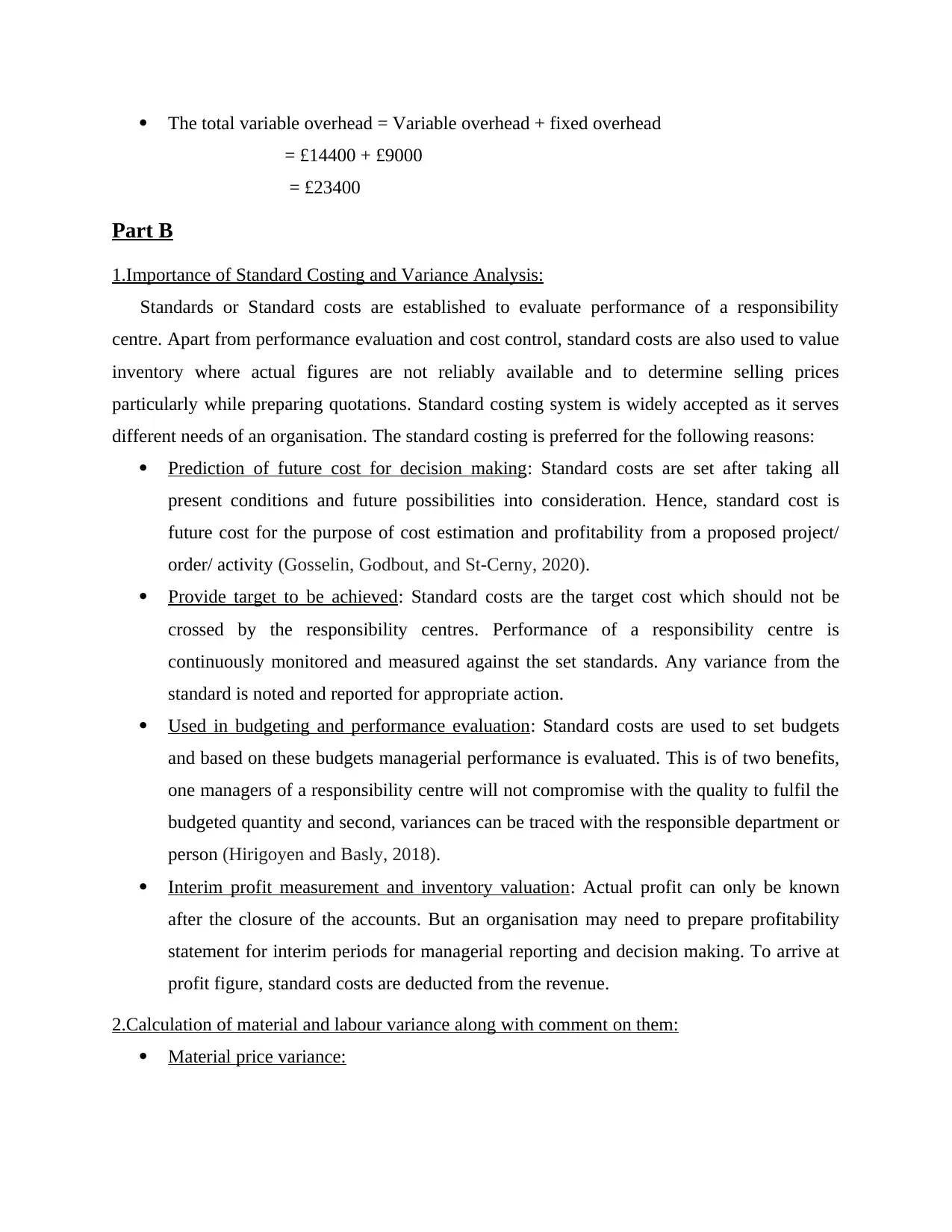
The total variable overhead = Variable overhead + fixed overhead
= £14400 + £9000
= £23400
Part B
1.Importance of Standard Costing and Variance Analysis:
Standards or Standard costs are established to evaluate performance of a responsibility
centre. Apart from performance evaluation and cost control, standard costs are also used to value
inventory where actual figures are not reliably available and to determine selling prices
particularly while preparing quotations. Standard costing system is widely accepted as it serves
different needs of an organisation. The standard costing is preferred for the following reasons:
Prediction of future cost for decision making: Standard costs are set after taking all
present conditions and future possibilities into consideration. Hence, standard cost is
future cost for the purpose of cost estimation and profitability from a proposed project/
order/ activity (Gosselin, Godbout, and St-Cerny, 2020).
Provide target to be achieved: Standard costs are the target cost which should not be
crossed by the responsibility centres. Performance of a responsibility centre is
continuously monitored and measured against the set standards. Any variance from the
standard is noted and reported for appropriate action.
Used in budgeting and performance evaluation: Standard costs are used to set budgets
and based on these budgets managerial performance is evaluated. This is of two benefits,
one managers of a responsibility centre will not compromise with the quality to fulfil the
budgeted quantity and second, variances can be traced with the responsible department or
person (Hirigoyen and Basly, 2018).
Interim profit measurement and inventory valuation: Actual profit can only be known
after the closure of the accounts. But an organisation may need to prepare profitability
statement for interim periods for managerial reporting and decision making. To arrive at
profit figure, standard costs are deducted from the revenue.
2.Calculation of material and labour variance along with comment on them:
Material price variance:
= £14400 + £9000
= £23400
Part B
1.Importance of Standard Costing and Variance Analysis:
Standards or Standard costs are established to evaluate performance of a responsibility
centre. Apart from performance evaluation and cost control, standard costs are also used to value
inventory where actual figures are not reliably available and to determine selling prices
particularly while preparing quotations. Standard costing system is widely accepted as it serves
different needs of an organisation. The standard costing is preferred for the following reasons:
Prediction of future cost for decision making: Standard costs are set after taking all
present conditions and future possibilities into consideration. Hence, standard cost is
future cost for the purpose of cost estimation and profitability from a proposed project/
order/ activity (Gosselin, Godbout, and St-Cerny, 2020).
Provide target to be achieved: Standard costs are the target cost which should not be
crossed by the responsibility centres. Performance of a responsibility centre is
continuously monitored and measured against the set standards. Any variance from the
standard is noted and reported for appropriate action.
Used in budgeting and performance evaluation: Standard costs are used to set budgets
and based on these budgets managerial performance is evaluated. This is of two benefits,
one managers of a responsibility centre will not compromise with the quality to fulfil the
budgeted quantity and second, variances can be traced with the responsible department or
person (Hirigoyen and Basly, 2018).
Interim profit measurement and inventory valuation: Actual profit can only be known
after the closure of the accounts. But an organisation may need to prepare profitability
statement for interim periods for managerial reporting and decision making. To arrive at
profit figure, standard costs are deducted from the revenue.
2.Calculation of material and labour variance along with comment on them:
Material price variance:
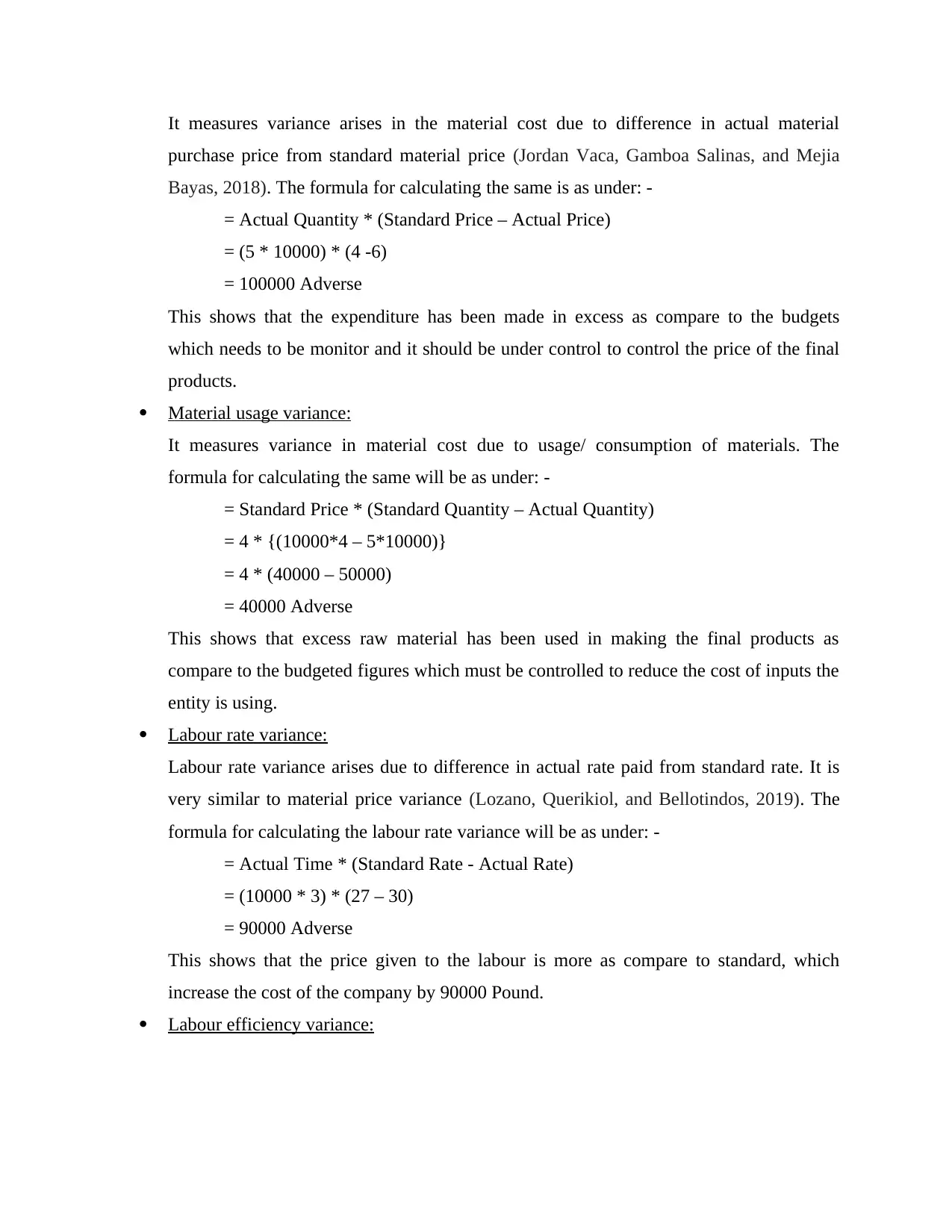
It measures variance arises in the material cost due to difference in actual material
purchase price from standard material price (Jordan Vaca, Gamboa Salinas, and Mejia
Bayas, 2018). The formula for calculating the same is as under: -
= Actual Quantity * (Standard Price – Actual Price)
= (5 * 10000) * (4 -6)
= 100000 Adverse
This shows that the expenditure has been made in excess as compare to the budgets
which needs to be monitor and it should be under control to control the price of the final
products.
Material usage variance:
It measures variance in material cost due to usage/ consumption of materials. The
formula for calculating the same will be as under: -
= Standard Price * (Standard Quantity – Actual Quantity)
= 4 * {(10000*4 – 5*10000)}
= 4 * (40000 – 50000)
= 40000 Adverse
This shows that excess raw material has been used in making the final products as
compare to the budgeted figures which must be controlled to reduce the cost of inputs the
entity is using.
Labour rate variance:
Labour rate variance arises due to difference in actual rate paid from standard rate. It is
very similar to material price variance (Lozano, Querikiol, and Bellotindos, 2019). The
formula for calculating the labour rate variance will be as under: -
= Actual Time * (Standard Rate - Actual Rate)
= (10000 * 3) * (27 – 30)
= 90000 Adverse
This shows that the price given to the labour is more as compare to standard, which
increase the cost of the company by 90000 Pound.
Labour efficiency variance:
purchase price from standard material price (Jordan Vaca, Gamboa Salinas, and Mejia
Bayas, 2018). The formula for calculating the same is as under: -
= Actual Quantity * (Standard Price – Actual Price)
= (5 * 10000) * (4 -6)
= 100000 Adverse
This shows that the expenditure has been made in excess as compare to the budgets
which needs to be monitor and it should be under control to control the price of the final
products.
Material usage variance:
It measures variance in material cost due to usage/ consumption of materials. The
formula for calculating the same will be as under: -
= Standard Price * (Standard Quantity – Actual Quantity)
= 4 * {(10000*4 – 5*10000)}
= 4 * (40000 – 50000)
= 40000 Adverse
This shows that excess raw material has been used in making the final products as
compare to the budgeted figures which must be controlled to reduce the cost of inputs the
entity is using.
Labour rate variance:
Labour rate variance arises due to difference in actual rate paid from standard rate. It is
very similar to material price variance (Lozano, Querikiol, and Bellotindos, 2019). The
formula for calculating the labour rate variance will be as under: -
= Actual Time * (Standard Rate - Actual Rate)
= (10000 * 3) * (27 – 30)
= 90000 Adverse
This shows that the price given to the labour is more as compare to standard, which
increase the cost of the company by 90000 Pound.
Labour efficiency variance:
⊘ This is a preview!⊘
Do you want full access?
Subscribe today to unlock all pages.

Trusted by 1+ million students worldwide
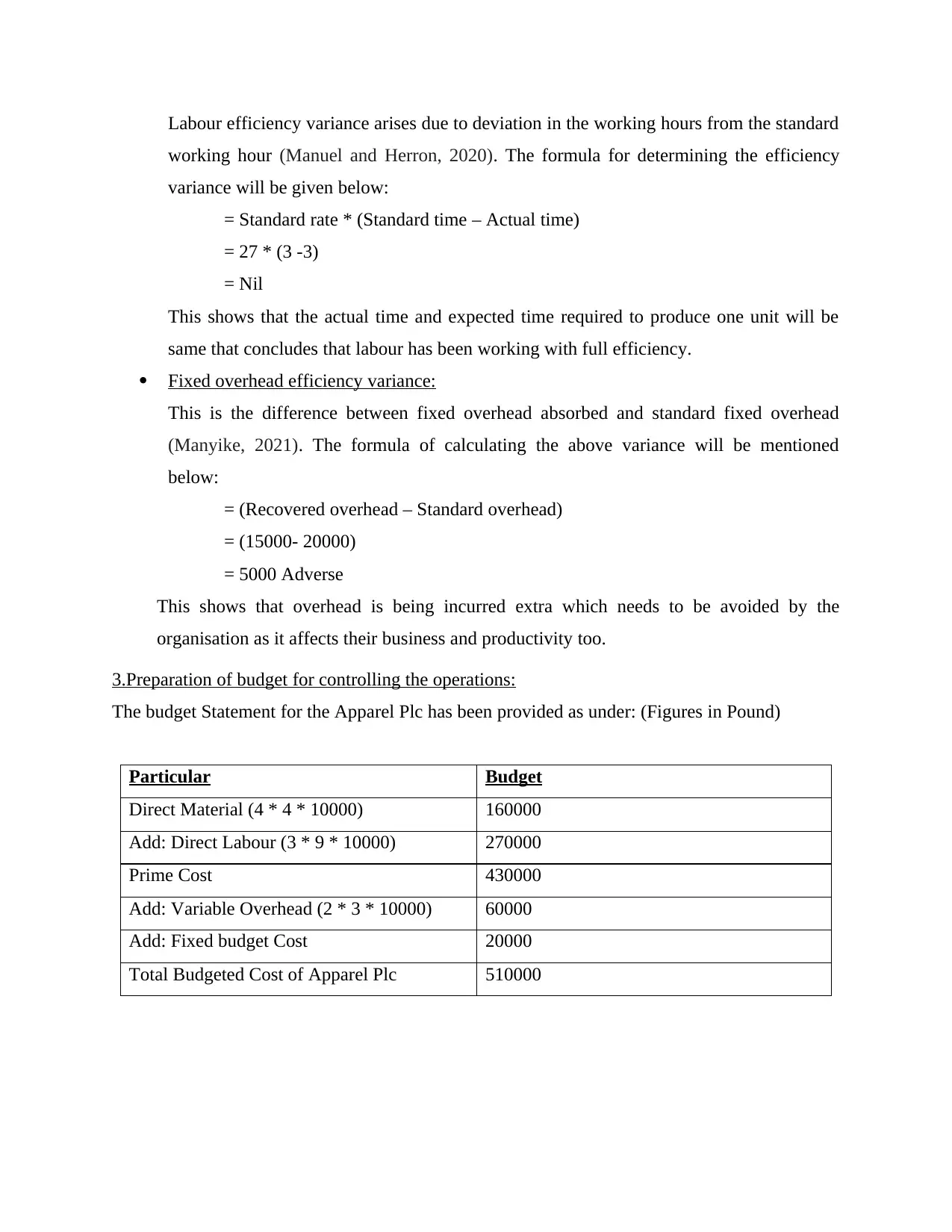
Labour efficiency variance arises due to deviation in the working hours from the standard
working hour (Manuel and Herron, 2020). The formula for determining the efficiency
variance will be given below:
= Standard rate * (Standard time – Actual time)
= 27 * (3 -3)
= Nil
This shows that the actual time and expected time required to produce one unit will be
same that concludes that labour has been working with full efficiency.
Fixed overhead efficiency variance:
This is the difference between fixed overhead absorbed and standard fixed overhead
(Manyike, 2021). The formula of calculating the above variance will be mentioned
below:
= (Recovered overhead – Standard overhead)
= (15000- 20000)
= 5000 Adverse
This shows that overhead is being incurred extra which needs to be avoided by the
organisation as it affects their business and productivity too.
3.Preparation of budget for controlling the operations:
The budget Statement for the Apparel Plc has been provided as under: (Figures in Pound)
Particular Budget
Direct Material (4 * 4 * 10000) 160000
Add: Direct Labour (3 * 9 * 10000) 270000
Prime Cost 430000
Add: Variable Overhead (2 * 3 * 10000) 60000
Add: Fixed budget Cost 20000
Total Budgeted Cost of Apparel Plc 510000
working hour (Manuel and Herron, 2020). The formula for determining the efficiency
variance will be given below:
= Standard rate * (Standard time – Actual time)
= 27 * (3 -3)
= Nil
This shows that the actual time and expected time required to produce one unit will be
same that concludes that labour has been working with full efficiency.
Fixed overhead efficiency variance:
This is the difference between fixed overhead absorbed and standard fixed overhead
(Manyike, 2021). The formula of calculating the above variance will be mentioned
below:
= (Recovered overhead – Standard overhead)
= (15000- 20000)
= 5000 Adverse
This shows that overhead is being incurred extra which needs to be avoided by the
organisation as it affects their business and productivity too.
3.Preparation of budget for controlling the operations:
The budget Statement for the Apparel Plc has been provided as under: (Figures in Pound)
Particular Budget
Direct Material (4 * 4 * 10000) 160000
Add: Direct Labour (3 * 9 * 10000) 270000
Prime Cost 430000
Add: Variable Overhead (2 * 3 * 10000) 60000
Add: Fixed budget Cost 20000
Total Budgeted Cost of Apparel Plc 510000
Paraphrase This Document
Need a fresh take? Get an instant paraphrase of this document with our AI Paraphraser
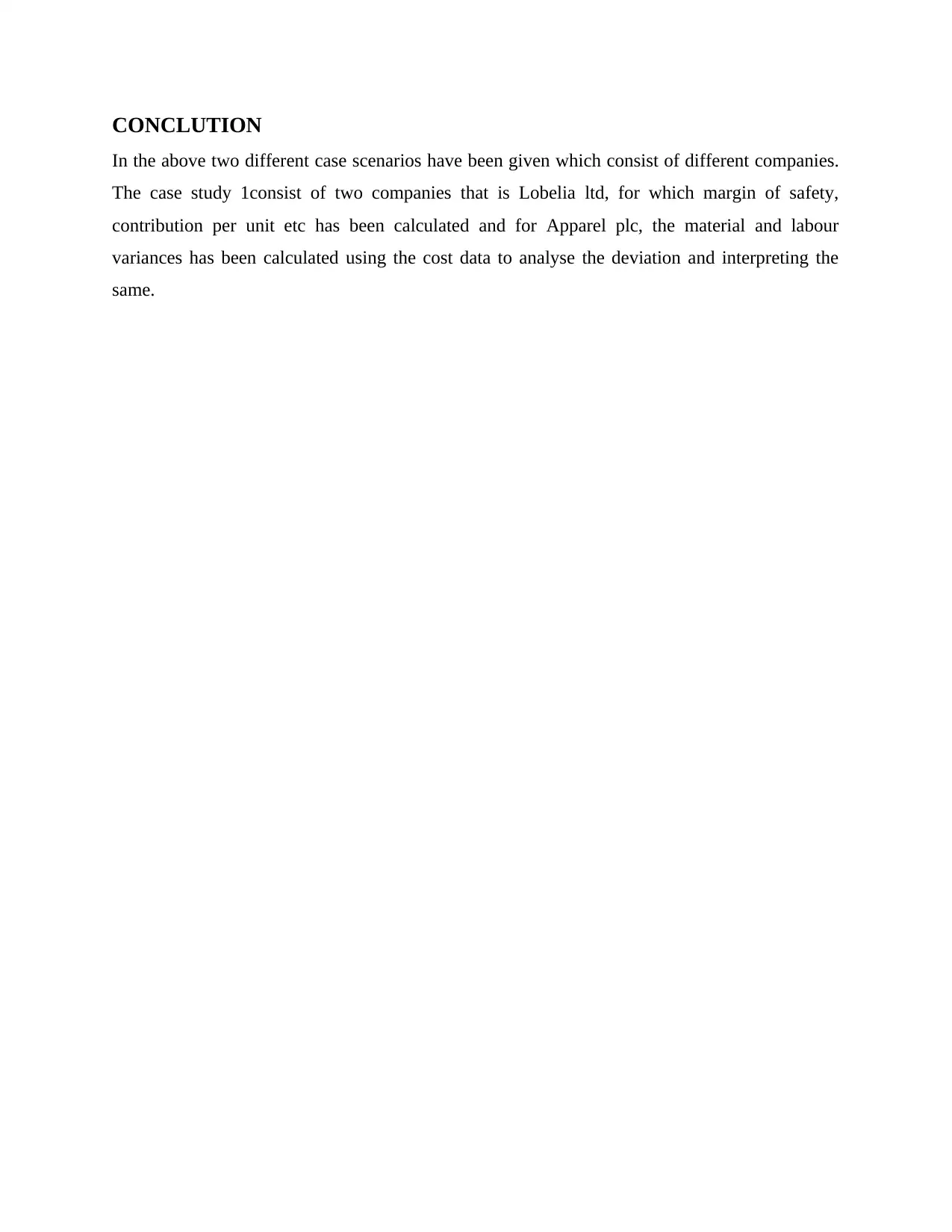
CONCLUTION
In the above two different case scenarios have been given which consist of different companies.
The case study 1consist of two companies that is Lobelia ltd, for which margin of safety,
contribution per unit etc has been calculated and for Apparel plc, the material and labour
variances has been calculated using the cost data to analyse the deviation and interpreting the
same.
In the above two different case scenarios have been given which consist of different companies.
The case study 1consist of two companies that is Lobelia ltd, for which margin of safety,
contribution per unit etc has been calculated and for Apparel plc, the material and labour
variances has been calculated using the cost data to analyse the deviation and interpreting the
same.
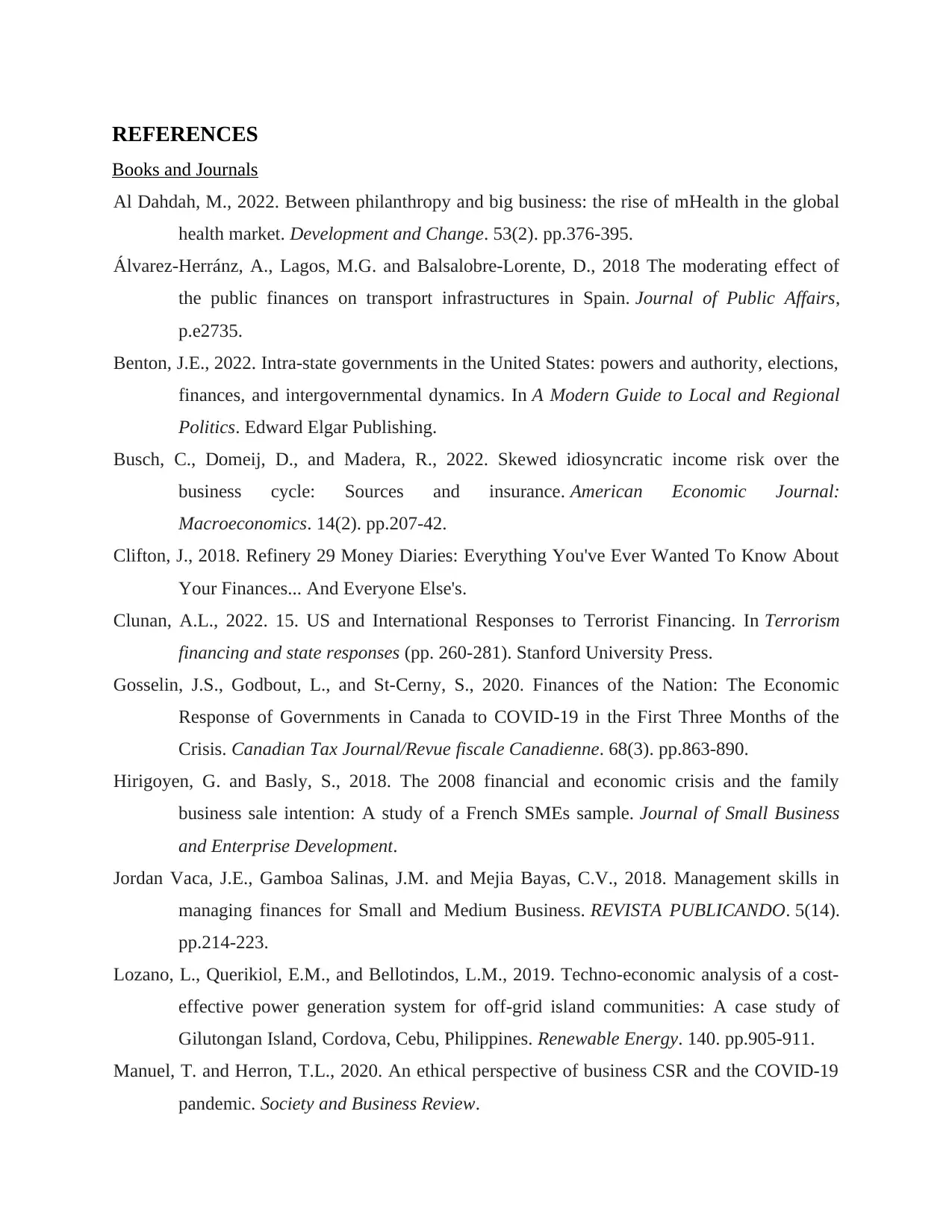
REFERENCES
Books and Journals
Al Dahdah, M., 2022. Between philanthropy and big business: the rise of mHealth in the global
health market. Development and Change. 53(2). pp.376-395.
Álvarez‐Herránz, A., Lagos, M.G. and Balsalobre‐Lorente, D., 2018 The moderating effect of
the public finances on transport infrastructures in Spain. Journal of Public Affairs,
p.e2735.
Benton, J.E., 2022. Intra-state governments in the United States: powers and authority, elections,
finances, and intergovernmental dynamics. In A Modern Guide to Local and Regional
Politics. Edward Elgar Publishing.
Busch, C., Domeij, D., and Madera, R., 2022. Skewed idiosyncratic income risk over the
business cycle: Sources and insurance. American Economic Journal:
Macroeconomics. 14(2). pp.207-42.
Clifton, J., 2018. Refinery 29 Money Diaries: Everything You've Ever Wanted To Know About
Your Finances... And Everyone Else's.
Clunan, A.L., 2022. 15. US and International Responses to Terrorist Financing. In Terrorism
financing and state responses (pp. 260-281). Stanford University Press.
Gosselin, J.S., Godbout, L., and St-Cerny, S., 2020. Finances of the Nation: The Economic
Response of Governments in Canada to COVID-19 in the First Three Months of the
Crisis. Canadian Tax Journal/Revue fiscale Canadienne. 68(3). pp.863-890.
Hirigoyen, G. and Basly, S., 2018. The 2008 financial and economic crisis and the family
business sale intention: A study of a French SMEs sample. Journal of Small Business
and Enterprise Development.
Jordan Vaca, J.E., Gamboa Salinas, J.M. and Mejia Bayas, C.V., 2018. Management skills in
managing finances for Small and Medium Business. REVISTA PUBLICANDO. 5(14).
pp.214-223.
Lozano, L., Querikiol, E.M., and Bellotindos, L.M., 2019. Techno-economic analysis of a cost-
effective power generation system for off-grid island communities: A case study of
Gilutongan Island, Cordova, Cebu, Philippines. Renewable Energy. 140. pp.905-911.
Manuel, T. and Herron, T.L., 2020. An ethical perspective of business CSR and the COVID-19
pandemic. Society and Business Review.
Books and Journals
Al Dahdah, M., 2022. Between philanthropy and big business: the rise of mHealth in the global
health market. Development and Change. 53(2). pp.376-395.
Álvarez‐Herránz, A., Lagos, M.G. and Balsalobre‐Lorente, D., 2018 The moderating effect of
the public finances on transport infrastructures in Spain. Journal of Public Affairs,
p.e2735.
Benton, J.E., 2022. Intra-state governments in the United States: powers and authority, elections,
finances, and intergovernmental dynamics. In A Modern Guide to Local and Regional
Politics. Edward Elgar Publishing.
Busch, C., Domeij, D., and Madera, R., 2022. Skewed idiosyncratic income risk over the
business cycle: Sources and insurance. American Economic Journal:
Macroeconomics. 14(2). pp.207-42.
Clifton, J., 2018. Refinery 29 Money Diaries: Everything You've Ever Wanted To Know About
Your Finances... And Everyone Else's.
Clunan, A.L., 2022. 15. US and International Responses to Terrorist Financing. In Terrorism
financing and state responses (pp. 260-281). Stanford University Press.
Gosselin, J.S., Godbout, L., and St-Cerny, S., 2020. Finances of the Nation: The Economic
Response of Governments in Canada to COVID-19 in the First Three Months of the
Crisis. Canadian Tax Journal/Revue fiscale Canadienne. 68(3). pp.863-890.
Hirigoyen, G. and Basly, S., 2018. The 2008 financial and economic crisis and the family
business sale intention: A study of a French SMEs sample. Journal of Small Business
and Enterprise Development.
Jordan Vaca, J.E., Gamboa Salinas, J.M. and Mejia Bayas, C.V., 2018. Management skills in
managing finances for Small and Medium Business. REVISTA PUBLICANDO. 5(14).
pp.214-223.
Lozano, L., Querikiol, E.M., and Bellotindos, L.M., 2019. Techno-economic analysis of a cost-
effective power generation system for off-grid island communities: A case study of
Gilutongan Island, Cordova, Cebu, Philippines. Renewable Energy. 140. pp.905-911.
Manuel, T. and Herron, T.L., 2020. An ethical perspective of business CSR and the COVID-19
pandemic. Society and Business Review.
⊘ This is a preview!⊘
Do you want full access?
Subscribe today to unlock all pages.

Trusted by 1+ million students worldwide
1 out of 23
Related Documents
Your All-in-One AI-Powered Toolkit for Academic Success.
+13062052269
info@desklib.com
Available 24*7 on WhatsApp / Email
![[object Object]](/_next/static/media/star-bottom.7253800d.svg)
Unlock your academic potential
Copyright © 2020–2025 A2Z Services. All Rights Reserved. Developed and managed by ZUCOL.




